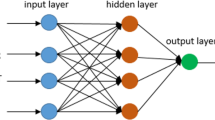Abstract
Wireless Sensor Networks (WSNs)-based networking systems introduces to transfer from traditional industry to digital industry, commonly known as the fourth stage of industrialization (Industry 4.0). The WSN is an encouraging technology for many industrial applications because of their several potential benefits. However, they impose several challenges when using them for various monitoring and control applications in the Industry 4.0. Improving lifetime and minimizing power consumption are the main challenges of wireless sensor networks. Solving this problem consist of optimizing node deployment, offering an energy-efficient routing protocol, and providing a clustering approach for sensor nodes in order to optimize battery utilization. Despite the fact that Cluster Head (CH) is overwhelmed with nodes traffic and dies quickly, in most studies, the choice of CH and the creation of clusters take into consideration only the value of residual energy in the sensor nodes, which causes an unequal load balance cluster. The purpose of this study is to propose an advanced clustering in wireless sensors networks, that takes into account not only the value of the residual energy but also the degree of connection, the distance between the CH and other network nodes and the antenna orientation. Besides, a drone routing approach based on artificial intelligence is adapted for data collection to overcome the problem of hot spot. The proposed approach is compared with existing clustering methods such as LEACH, LEACH-C, and LEACH-B that are designed for fixed WSNs. The results of simulations obtained depict that clustering algorithm with optimized routing significantly improves the network lifetime.







Similar content being viewed by others
References
Al-Baz A, El-Sayed A (2017) A new algorithm for cluster head selection in LEACH protocol for wireless sensor networks. Int J Commun Syst 31(1):e3407. https://doi.org/10.1002/dac.3407
Arya R, Sharma SC (2018) Energy optimization of energy aware routing protocol and bandwidth assessment for wireless sensor network. Int J Syst Assur Eng Manag 9:612–619
Borges LM, Velez FJ, Lebres AS (2014) Survey on the characterization and classification of wireless sensor network applications. IEEE Commun Surv Tutorials 16(4):1860–1890
Caillouet C, Giroire F, Razafindralambo T (2019) Efficient data collection and tracking with flying drones. Ad Hoc Netw 89:35–46
Cheng L, Wu C, Zhang Y, Wu H, Li M, Maple C (2012) A survey of localization in wireless sensor network. Int J Distrib Sens Netw 8(12):962523
Ding XX, Ling M, Wang ZJ, Song FL (2017) Dk-leach: an optimized cluster structure routing method based on leach in wireless sensor networks. Wirel Pers Commun 96(4):6369–6379
Ghorbel MB, Rodriguez-Duarte D, Ghazzai H, Hossain MJ, Menouar H (2018) Energy efficient data collection for wireless sensors using drones. In 2018 IEEE 87th Vehicular Technology Conference (VTC Spring), pp. 1–5
Guiloufi ABF, Nasri N, Farah MAB, Kachouri A (2013) MED-BS clustering algorithm for the small-scale wireless sensor networks. Wirel Sens Netw 5(4):67–75
Jannu S, Jana PK (2016) A grid based clustering and routing algorithm for solving hot spot problem in wireless sensor networks. Wirel Netw 22(6):1901–1916
Kaur A, Kumar P, Gupta GP (2018) Nature inspired algorithm-based improved variants of dv-hop algorithm for randomly deployed 2d and 3d wireless sensor networks. Wirel Pers Commun 101(1):567–582
Khabiri M, Ghaffari A (2018) Energy-aware clustering-based routing in wireless sensor networks using cuckoo optimization algorithm. Wirel Pers Commun 98(3):2473–2495
Krishnan M, Rajagopal V, Rathinasamy S (2018) Performance evaluation of sensor deployment using optimization techniques and scheduling approach for K-coverage in WSNs. Wireless Netw 24(3):683–693
Lin CJ, Chou PL, Chou CF (2006) HCDD: hierarchical cluster-based data dissemination in wireless sensor networks with mobile sink. In: Proceedings of international conference on wireless communications and mobile computing, 03–06 Jul 2006, Vancouver, Canada, pp 1189–1194
Mahboubi H, Masoudimansour W, Aghdam AG, Sayrafian-Pour K (2016) Maximum lifetime strategy for target monitoring with controlled node mobility in sensor networks with obstacles. IEEE Trans Autom Control 61(11):3493–3508
Manimurugan S, Porkumaran K, Narmatha C (2014) The new block pixel sort algorithm for TVC-encrypted medical image. Imaging Sci J 62(8):403–414
Mezghani M (2019) An efficient multi-hops clustering and data routing for WSNs based on Khalimsky shortest paths. J Ambient Intell Human Comput 10:1275–1288
Musa A, Gonzalez V, Barragan D (2019) A new strategy to optimize the sensors placement in wireless sensor networks. J Ambient Intell Humaniz Comput 10(4):1389–1399
Narmatha C, Manimurugan S (2014) A new approach for iris image identification using modified contour segmentation. In: Proceeding of the IEEE International Conference on Green Computing, Communication and Electrical Engineering, ICGCCEE 2014. Institute of Electrical and Electronics Engineers Inc. https://doi.org/10.1109/ICGCCEE.2014.6921399
Nasri N, Ben Fradj A, Kachouri A (2017) Optimised cross-layer synchronisation schemes for wireless sensor networks. Int J Electron 104(7):1178–1189
Nejah N, Sami M, Thierry V (2020) 3D node deployment strategies prediction in wireless sensors network. Int J Electron 107(5):808–838
Sarkar A, Murugan TS (2019) Cluster head selection for energy efficient and delay-less routing in wireless sensor network. Wireless Netw 25(1):303–320
Zhang W, Zhang Z, Chao HC, Liu Y, Zhang P (2017) System-level energy balance for maximizing network lifetime in WSNs. IEEE Access 5:20046–20057
Zhang H, Wang Z, Gulliver TA (2018) Two-stage weighted centroid localization for large-scale wireless sensor networks in ambient intelligence environment. J Ambient Intell Humaniz Comput 9(3):617–627
Author information
Authors and Affiliations
Corresponding author
Additional information
Publisher's Note
Springer Nature remains neutral with regard to jurisdictional claims in published maps and institutional affiliations.
Rights and permissions
About this article
Cite this article
Alrashidi, M., Nasri, N., Khediri, S. et al. Energy-Efficiency Clustering and Data Collection for Wireless Sensor Networks in Industry 4.0. J Ambient Intell Human Comput (2020). https://doi.org/10.1007/s12652-020-02146-0
Received:
Accepted:
Published:
DOI: https://doi.org/10.1007/s12652-020-02146-0




